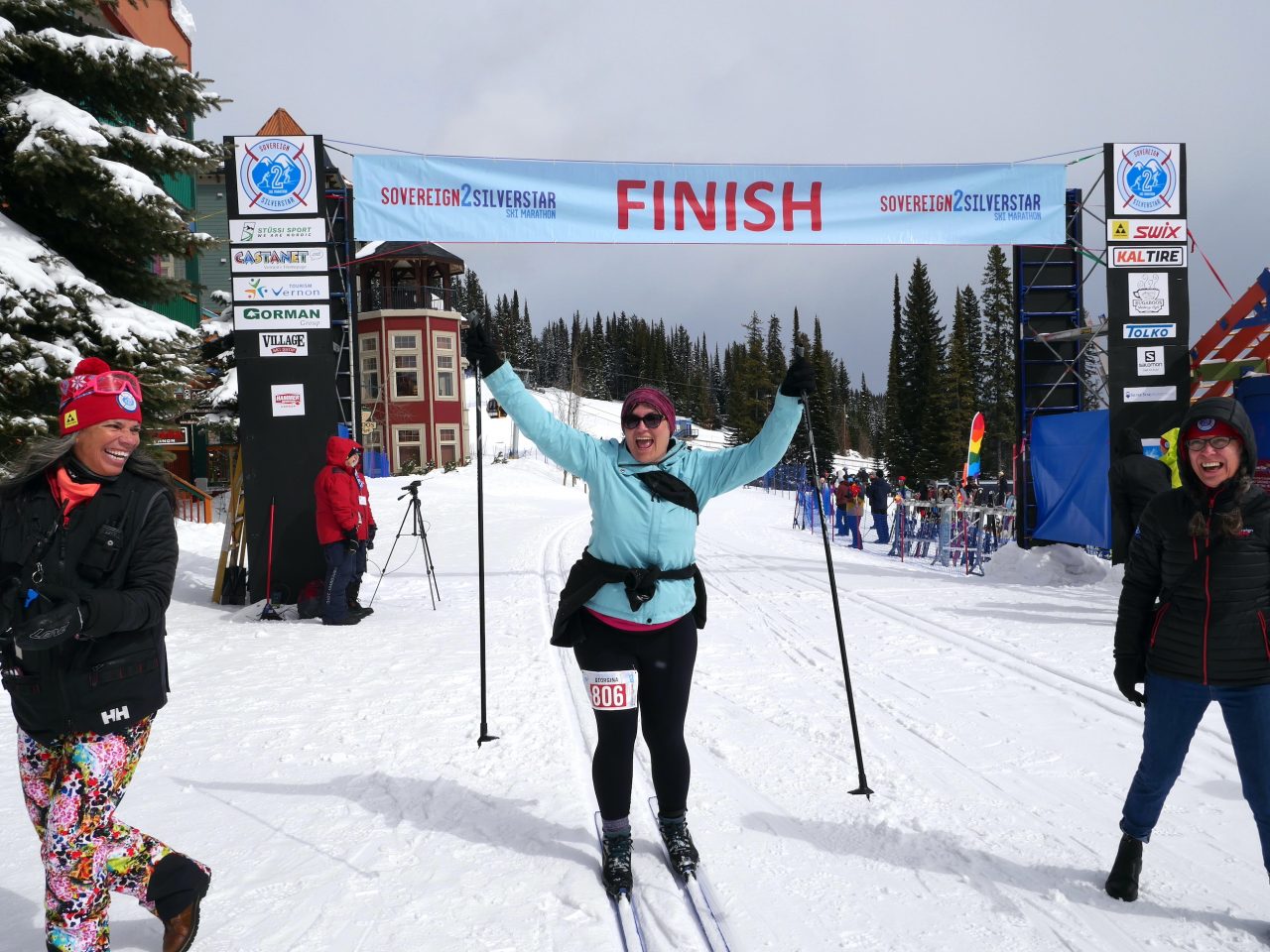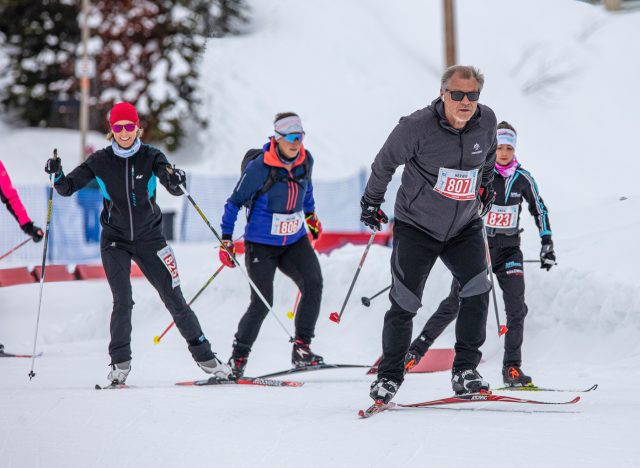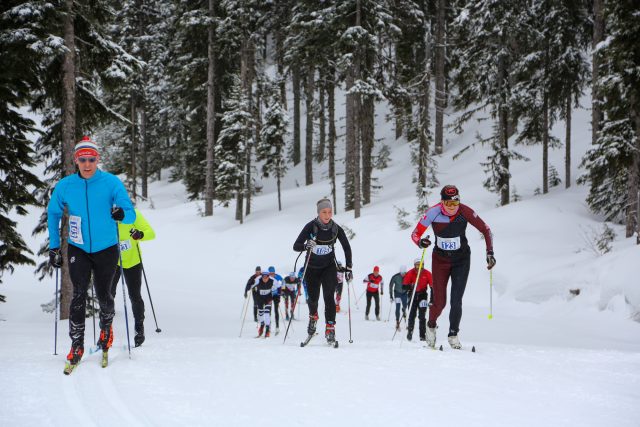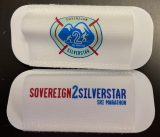
Disclaimer: The author skied both days and was one member of the large S2S organizing committee. This may seem like a conflict of interest, but also allows a more detailed look behind the curtain at how a new event was built.
Click here to learn more about the origins of the Sovereign2Silverstar Ski Marathon, and to take a look at the successful first year of the event.
***
The motto for S2S was ‘finishing is winning’, a phrase that also served as the touchstone for the bigger decisions.
The members of the Organizing Committee (OC) had a lot of experience hosting ski races, from local loppets to Canada Cup/SuperTour weekends to World Cups, and even a combined Nationals plus SuperTour Finals that got cancelled by a pandemic in 2020. A destination event is a different beast, however. High-level events under the FIS umbrella don’t need marketing: athletes follow the events calendar. Local loppets are advertised with a few posters at the neighbouring ski areas. FIS events have required distances, homologated courses, and rules for everything.
A destination event, by definition, has to entice skiers to travel. In the midst of a pandemic, this is not as easy as it once was, even to a destination with quality late-season snowpack and a mountain backdrop. The question then becomes, ‘What can be done to make the event attractive?’ Immediately followed by ‘how can we keep the participants, volunteers, and local community safe?’
Year 1 went well, with lots of smiles generated.

Which skiers?
The club already hosts high level events in nordic and biathlon, which led the OC to a focus on inclusion for the new event.
To get a larger number of skiers, it is necessary to look outside the group of committed competitors and attract recreational skiers. Thus, the motto ‘Finishing is Winning’ was chosen to both appeal to non-racers but also give the OC a vision to follow.
The motto led to a list of goals: Inclusive. No time limit. Small waves. No technically difficult course features. A minimum of climbing, but enough to discourage classic racers from double poling on skate skis.
When?
One of the original goals was to show the trail system at its best, which means late March and early April. March is most often the big snowfall month and has been the choice for the annual 30km for two decades. The elite skiers always visit in early December or late November for Continental Cup races. As a result, generations of racers have visited just before the skiing gets really good.
The OC wanted to add to the season calendar instead of competing with existing events. Choosing the same weekend as the American Birkie, for example, would limit future growth.
The early 2021/2022 international calendar had no events for April 2nd and 3rd.
Using historical data, there is a 70% chance of blue hard wax skiing on the first weekend of April. Unfortunately, history doesn’t account for climate change and the increasing risk of extreme weather. In 2021, the Vernon area set new records for lowest precipitation in March, April, and May, based on data going back to 1904. In June, heat records were broken all over BC and Washington state. Then, an atmospheric river in November washed away all four highways to Vancouver and dramatically thinned the snowpack.
With the extreme 2021 weather as a backdrop, there was some nervousness about hosting in April. Club members are usually committed to cycling and paddling by mid-March. An entire web page was devoted to showing what April skiing looks like.
The final choice also became an effort to change perceptions. In a year where many people were limiting travel and pandemic rules changed monthly, success would depend on persuading local skiers to keep skiing into April. Early data suggests there were more skier visits in late March and early April than previous years.
Shortly after the OC committed to the dates, the Fossavatn moved to the same weekend and in December the Alex Harvey Classic was announced. The worldwide calendar is crowded, and there really aren’t any ’empty’ weekends.
Course Design
At this venue, a long flat double pole route is simply not an option. Sovereign Lake is a small pond and the flat trail around it is less than 1km long. Spectacular mountain views like Canmore or Toblach require nearby mountains and the twin ski areas are just part of the Interior Plateau that was eroded less after the glaciers receded. What the OC does have is twisting, rolling trails through a coniferous forest, tonnes of snow, and a few beautiful viewpoints.
Many of the OC had skied in events with fast downhills, wild corners, road crossings, and chaotic starts. To be inclusive to newer skiers, the course would avoid tight switchbacks, avoid steep climbs, and be relatively flat.
Starting in the Sovereign Lake stadium and finishing on Main Street in SilverStar village were the main selling points. With that decided, the Alder Point loop was essential, with views of the Monashee mountains on one side and views of many alpine runs busy with skiers on the other. That decided, it was a matter of building a route with no repeats, no technical sections, a moderate amount of climbing, and exactly 42km long.
There were many candidate routes that met the requirements, but there was also a 40km route that was more fun to ski.
After some debate, the OC decided that the fun 40km course fit the ‘Finishing is Winning’ motto best. The first 10km is a flat warmup before the climbing starts. There are three ‘long climb’ sections with about 70m gained over 3km. The finish is a gentle 3km downhill leading into a ‘feature’ finish onto Main Street.
Exact distances can be important. While every long-time skier has done events that are very different than advertised, some participants want precision. And precision usually means that their watch or phone records the exact advertised numbers.
There are two common causes of GPS accuracy errors: mountains and trees. As the venue is well equipped with both, the OC quickly learned that only the homologated loops had accurate mapped distances. A sub-team was recruited to get more accurate map data using LIDAR data.
Scanning through Strava on April 3rd, most of the 40km skiers posted distances between 38km and 41km. The measured elevation gains varied even more.
The 21km course splits from the long course at the 5km point, heading directly to SilverStar while the 40km skiers ski a 17km loop to arrive at the same intersection from another direction. The 21km course also skips the final climbing section up Howie’s loop and on the Bergstrasse alpine run.
Making the 21km a subset of the 40km course and using the same course both days resulted in a huge reduction in volunteer effort.
Small Waves
Many of the OC had skied in major events where there were queues at the first pinch point. To be inclusive to non-racers who aren’t used to skiing in a pack, the decision was made to spread the skiers out so they could watch the scenery instead of the butt of the skier in front. The final choice was a series of waves, spaced three minutes apart.

The largest wave had 42 skiers and it spread out quickly. The telephoto and steep hill combine to compress the B wave group above, which is actually spread out over about 100m of the short climb.
The first pinch point on the 40km course is at 21km, where the packed trail is only 6m wide and there is just enough room to skate two abreast. The lead pack on classic day was three skiers here, mostly because the short climbs in the Zumas tend to explode packs.
A few skiers didn’t like the small waves while most participants loved the space to ski at their own pace. The elite skiers were indifferent to wave size, possibly because they would immediately ski away from any size of group.
Working Together
SilverStar Mountain Resort is a commercial alpine ski area answering to shareholders, with trails for nordic, snowshoeing, and fat biking. Sovereign Lake Nordic Club is a 3,200 member ski club set in a provincial park, answerable to the nordic skiing members and BC Parks. Twin nordic areas to be sure, but fraternal not identical.
The differences between the areas can sometimes make it challenging to reach win/win consensus, but the desire to work together gets there in the end.
The local community has dreamed of a joint nordic event for years. In 2021, three people came up with a vision that both areas could say yes to, resulting in the birth of the 50/50 event committee. That name was abandoned, as it was quickly apparent that any 50km course would be more epic than inclusive (see an example course profile here).
The local snowmobile club loaned us 500m of one of their trails for five days, allowing the removal of two tricky hairpins and giving locals a new experience.
Learning From Others
The US Birkie and the Gatineau OC’s provided example budgets, registration advice, examples of what can go wrong. And then each event provided a top OC volunteer to spend an hour answering questions from the S2S OC. The nordic skiers on the OC thought this level of assistance was extremely helpful, but not unexpected. The alpine skiers on the OC were surprised that major events would actively help their ‘competition’.
Cortina-Dobbiaco is a good example of a fun event: point to point, one day for each technique, and a big effort to create an experience beyond the race.
The Vasaloppet is an example of how to grow big, but also an example of crowd management.
Other events the OC took ideas from include the Birkenbeiner, Engadin, Hoppet, Merino Muster, Moonlight Classic, and Ski To The Sun.
The decision to join the Visma Ski Classics challenger series was a surprise. One of the Cortina-Dobbiaco OC had explained the economics of the ProTour series, which put that idea on the year six or later list. Then it was discovered that the chief of volunteers knows every skier in every country, which led to a Norwegian friend of his making a pitch for the Ski Classics Challengers series and a cost-effective way to connect with a worldwide group of skiers who like to build vacations around ski events.
The Region
Vernon is an unusual place. The three lakes are just under 400m above sea level. The mountain bike trails at Kalamalka lake sprawl up the east ridge to 1,400m. Some years, the lower mtb trails are good all winter. Other years, the snow level is lower and bikers are waiting for April for the trails to dry. The nordic trails are higher, ranging from 1,500m to 1,915m. Skiing starts in October, with grooming beginning in early November. In April, the grooming stops when the supply of skiers runs out. In non-pandemic years, the Spring Fling snow camp in May provides an opportunity to start the new training year on groomed snow. SLNC and SilverStar have a combined 105km of nordic trails, groomed daily.
Vernon is a ‘small town’ of 40,000 people with strong sports communities and a high proportion of retirees. Silverstar village has a smaller population and an even larger sense of community. Some of the volunteers that committed hours as course marshals on the alpine run crossings are alpine skiers who have never tried nordic skiing.
Charitable Partner
Our target audience of adults who travel to ski events could be called privileged. With so many skiers who appreciate what sport has given them, the OC wanted to find a charity that could give sport to others. KidSport is an organization that helps financially disadvantaged youth participate in organized sport and the local chapter was a good fit for our goals.
The first year of any event is financially challenging and breaking even can be difficult. With an unknown event during a pandemic that wasn’t ending as quickly as hoped, there was uncertainty around raising a significant amount of money for the cause. Thanks to strong support from sponsors, volunteers, and skiers, the event raised $8,000, about 20% of the local division’s annual budget.
It turns out that partnering with a charity makes it easier to attract sponsors and volunteers, an unexpected but welcome benefit.
Promotion
There is a popular quote: ‘if you build it, they will come.’ A more useful version would be ‘if you invite people, they will come.’

Partnering with an alpine ski area comes with some significant advantages here. SilverStar has a marketing team with skills far above what is common in the North American nordic community. A stunning logo, word mark (that ‘text’ brand image), event colour scheme (based on both areas’ existing colours), and a branding document allowed the OC to present a consistent and attractive package to skiers, volunteers, and sponsors.
While ‘branding’ has always been an essential element in creating a successful business, it is equally valuable in building a new event. Many of the participants commented on how much this first event felt ‘organized’ and ‘polished’. A big part of that comes from providing a good athlete experience, but the polish is a direct result of that branding document.
Volunteers
Last on the page, but not last in importance. Over 250 volunteers worked tirelessly to bring energy and enthusiasm to the event day experience. Dozens of skiers made the effort to find someone wearing an ‘OC’ bib to talk about the atmosphere generated by the volunteers.
How much did the OC value the volunteers? When the financial team had to make hard choices to be ready for a last minute cancellation by any of three levels of government, one of the expenses eliminated was a toque for each participant. Because if you spend all the entry fee money in advance, how will you provide refunds?
The Volunteer team worked with one of the sponsors to give every volunteer a toque (a toque is a ski hat to Americans, a beanie to Brits). Thanks to supply chain constraints we all are living with, the sponsor had to pay the expense months in advance. Another sponsor provided food and drink for a volunteer party on Sunday afternoon. Many of the elite skiers and past Olympians known to FasterSkier readers made the effort to connect with the volunteers at the party.
In the end, the volunteers are what brought smiles to the participants faces. The event will need those people next year, which means showing volunteers the love is one of the biggest steps towards a successful second year.



